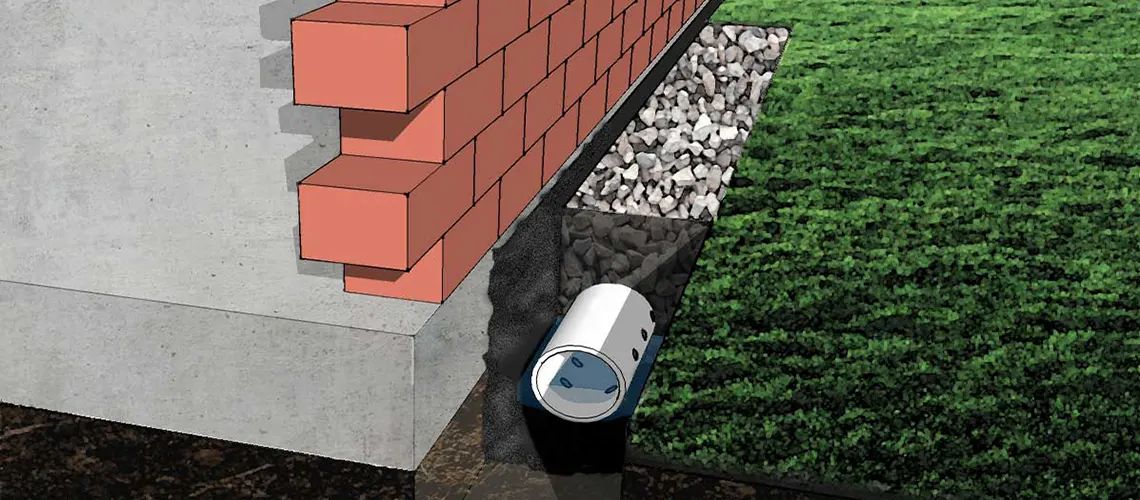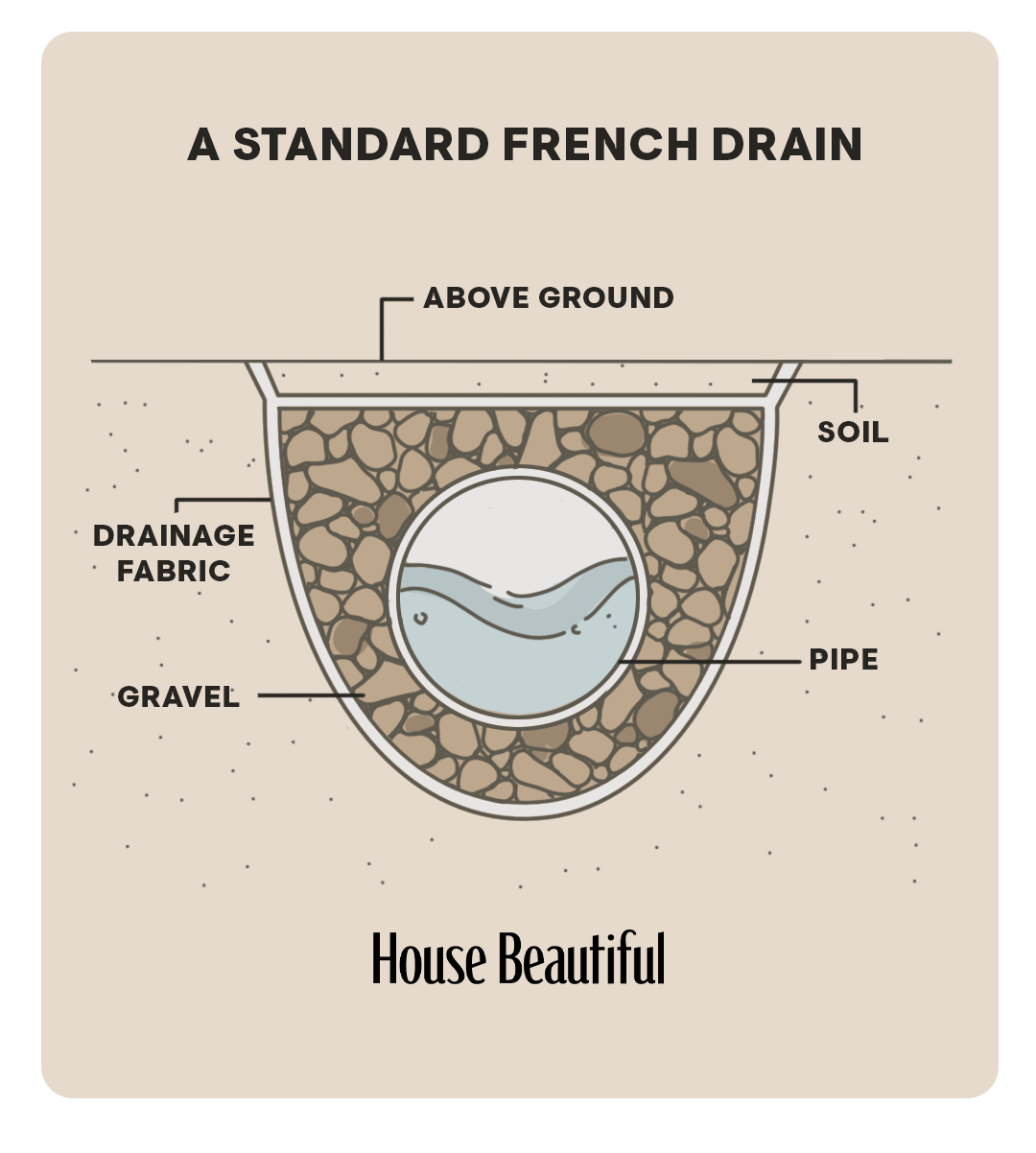The Necessary Overview to Keeping Your French Drain for Durable Performance
Maintaining your French drain is crucial to its efficiency and your home's protection. Normal checks can save you from expensive repair services and water damages. You'll wish to know what indications to search for and just how often to check your system. Plus, recognizing the cleaning procedure can make a considerable distinction. Allow's discover the important actions for ensuring your drainpipe functions well for several years to find.
Recognizing the Feature of a French Drainpipe
A French drainpipe is a critical part in handling water around your home. It directs excess water far from your structure, protecting against flooding and damage. When heavy rainfall falls, the drainpipe accumulates water with a perforated pipe hidden in crushed rock. This system permits water to stream easily, minimizing stress on your cellar walls and reducing the danger of leaks.You might question exactly how it operates in technique. As water fills the soil, gravity pulls it towards the drain. The perforated pipeline records this water, moving it to a designated water drainage area or tornado sewage system. This procedure keeps your lawn completely dry and shields your home's architectural integrity.Understanding exactly how a French drainpipe functions is crucial to appreciating its significance. By effectively carrying water away, it aids maintain a risk-free and completely dry living atmosphere. Maintaining your French drain in top problem warranties you avoid expensive fixings down the line.
Routine Assessments: What to Look For
Start by examining for any clogs that could be obstructing water flow when you're checking your French drain. Take note of indicators of surface erosion around the drainpipe, as this can show possible concerns. Routine evaluations will assist maintain your water drainage system operating effectively.
Obstructed Drainpipe Assessment
How can you inform if your French drainpipe is clogged? Initially, watch for water pooling in your yard, especially after heavy rain. If you discover locations where water accumulates instead of draining, that's a red flag. You should likewise examine the drainpipe outlet; if water isn't spurting as it should, there's likely a clog. Pay attention for unusual gurgling audios, which can suggest trapped air. Additionally, examine the drainpipe's surface area for any kind of vegetation growth, as roots can block the system and infiltrate. If you scent moldy smells, it could aim to stationary water triggered by a clog. Routinely examining these signs can assist you keep your French drain effectively and stop costly repair services.
Surface Area Erosion Check

Cleansing Your French Drainpipe: Step-by-Step Guide
Cleansing your French drainpipe is necessary for keeping it working appropriately. You'll require some certain devices and a clear process to assure everything runs smoothly. Let's go through the actions and tips for maintaining your drainpipe properly.
Devices You'll Need
To tackle the job of cleaning your French drainpipe properly, you'll desire to gather a couple of crucial tools. Grab a sturdy set of gloves to protect your hands from particles and sharp things. A little shovel or trowel will certainly help you eliminate dirt or clogs around the drain. For clearing out the inside, a plumbing professional's snake or a high-pressure water nozzle can be exceptionally valuable. You'll also require a pail for accumulating any type of particles you draw out. Ultimately, having a yard pipe accessible will make it simpler to rinse out the drain and ensure it's moving smoothly. With these tools all set, you'll be set for a thorough cleansing session!
Cleansing Refine Actions
Begin by evaluating the location around your French drain for any noticeable particles or obstructions. Eliminate fallen leaves, branches, or dirt that might block water flow. Next off, inspect the inlet and outlet areas; clear any kind of blockages to guarantee appropriate drainage. Use a yard hose pipe to flush the drainpipe, routing water into the inlet. This helps dislodge any type of collected sludge or sediment. If you discover relentless clogs, consider using a plumber's serpent to break them up. After cleaning, inspect the crushed rock around the drain; restore it if it's gotten rid of. Validate the drainpipe covers are undamaged and safely in area to stop debris from going into. Regular cleansing maintains your French drain operating properly.
Maintenance Regularity Tips
While routine maintenance is essential for your French drain's durability, knowing just how often to maintain it can make all the distinction. Ideally, you need to check your French drainpipe at the very least twice a year, preferably in springtime and autumn. After hefty rains or snowmelt, check for obstructions or debris. If you discover any standing water, it's time to clean your drain.In areas with hefty vegetation, more frequent maintenance-- concerning every 3 months-- may be needed. In addition, take into consideration cleaning your French drain after significant storms or if you observe water merging in your backyard. By remaining positive, you'll ensure your French drainpipe functions successfully and shields your home from water damages. Routine checks will save you time and cash over time.
Identifying Typical Issues and Their Solutions
It's important to recognize common issues with your French drainpipe and execute effective services when you see water pooling in your lawn or damp spots in your basement. One regular trouble is clogging, usually triggered by particles like fallen leaves or debris. To fix this, you can use a pipes snake or a high-pressure water jet to clear blockages.Another problem may be improper slope. If your drain isn't sloped properly, water will not move far from your home. You can readjust the incline by excavating and repositioning the drain pipe.Lastly, look for damages or cracks in the drainpipe itself. If you locate any kind of, replacing the harmed sections is vital for peak performance. By resolving these issues promptly, you'll aid guarantee that your French drain remains to operate click for more effectively, shielding your home from water damages and maintaining a dry, secure atmosphere.
Seasonal Maintenance Tips for Your French Drain
Resolving common problems with your French drainpipe is simply the primary step in assuring its long-lasting performance. Seasonal upkeep is vital for peak performance. In the spring, remove leaves and particles that may have accumulated throughout winter season. Look for any kind of obstructions in the electrical outlet or capture container, as water needs a clear course to flow freely.During summertime, check your drain for any kind of signs of resolving or moving dirt. Ensure it's still degree and functioning correctly. As fall approaches, tidy useful reference out any kind of fallen delegates avoid clogs before winter months arrives.In winter season, watch for freezing temperature levels. If you live in a cool climate, make certain your drain isn't in danger of cold. Protecting subjected pipes can aid. Routine checks and timely upkeep can avoid pricey fixings and keep your French drain functioning successfully year-round. Stay aggressive and take pleasure in comfort knowing your drain system is in good condition!
When to Hire an Expert
Understanding when to hire an expert can conserve you time and stop more damages to your French drainpipe. It's a clear indication that your drain might be obstructed or harmed if you see relentless standing water in your yard. Don't neglect odd odors, as they can show sewer back-up or decay, which needs prompt attention.If you find that your drain isn't operating correctly after efforts to tidy or preserve it, it's time to reach out for expert help. Furthermore, if you're unsure concerning the underlying problems or lack the needed tools, working with a professional can supply peace of mind.Finally, if your French drainpipe is old or has actually experienced significant deterioration, professional analysis can determine whether repairs or total replacement is needed. Trust fund the specialists to ensure your drainage system functions efficiently for several years ahead.
Tips for Protecting Against Future Drainage Troubles
To keep your French drain working successfully, consistently examining and maintaining it can make all the difference. Start by getting rid of particles, leaves, and dust from the surface and drain openings. This protects against obstructions that can bring about water back-up. Examine the gravel around the drain; if it's compacted or deteriorated, think about including fresh crushed rock to maintain perfect flow.Next, draw away water away from your drainpipe by Recommended Site making certain seamless gutters and downspouts are clear and directing water at least 3 feet away from your foundation. Consistently evaluate for any type of indicators of damage or drooping. If you notice issues, address them immediately.Finally, take into consideration installing a filter or a catch basin to catch larger debris before it enters the drain. By remaining positive with these ideas, you'll reduce the risk of future drain problems and keep your French drain in top form.
Regularly Asked Inquiries
Just how Lengthy Does a French Drain Commonly Last?
A French drain typically lasts around 30 to 40 years, depending upon the products made use of and upkeep (Portland French Drain). If you maintain up with normal checks, you can expand its lifespan even additionally
Can I Set Up a French Drain Myself?
Yes, you can set up a French drainpipe yourself if you have actually obtained the right devices and understanding. Just ensure to intend thoroughly, follow regional guidelines, and guarantee appropriate drainage to stay clear of future problems.
What Materials Are Used in a French Drainpipe?
You'll require perforated pipeline, crushed rock, landscape fabric, and a solid drainage pipeline for your French drain. These materials help redirect water effectively, preventing flooding and maintaining your property secure and completely dry from water damage.

Is a Permit Required to Set Up a French Drain?
You'll likely require an authorization to install a French drain, depending upon local guidelines. Inspect with your municipality to ensure you abide by any type of essential guidelines and stay clear of potential problems throughout setup.
What Are the Prices Related To French Drain Maintenance?
Maintaining a French drain normally sets you back between $100 and $500 yearly. You'll need to take into account expenses for cleansing, fixings, and assessments. Normal maintenance helps protect against larger expenses and guarantees your system functions properly for several years - Portland French Drain. When you're checking your French drainpipe, begin by examining for any kind of clogs that could be blocking water circulation. By remaining proactive, you'll guarantee your French drain features properly and safeguards your building from water damages. When you see water merging in your backyard or damp places in your basement, it's crucial to identify typical problems with your French drainpipe and execute efficient services. You can adjust the slope by digging and rearranging the drainpipe pipe.Lastly, check for damage or fractures in the drain itself. Inspect the gravel around the drain; if it's compacted or worn down, consider including fresh crushed rock to preserve suitable flow.Next, draw away water away from your drain by guaranteeing gutters and downspouts are clear and guiding water at the very least 3 feet away from your foundation